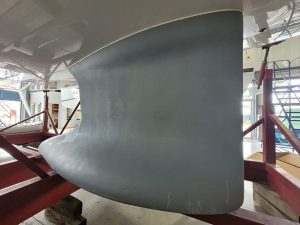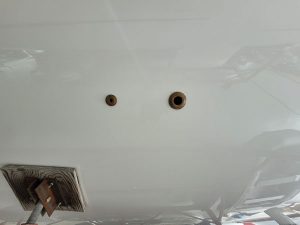The ultimate sealant for keel seal and through-hull seal

True-Hull Seal is the sealant to use for redoing a keel seal and for waterproofing a through-hull or any other component that needs to be installed under the water line. It is designed for easy and efficient application. Its texture allows for a smooth and uniform finish that can be painted. True-Hull Seal provides the flexibility and durability required to withstand stress on the keel seal.
True-Hull Seal must be stored at room temperature. Any residue is easily washed off with dish soap. After use, ensure that the tube is adequately sealed prior to storage.
Instructions
Instructions for the Through-hull
- Remove the existing through-hull.
- Sand.
- Thoroughly clean the surface to be glued using products such as acetone or MEK.
- Connect the valve and the inner pipe properly while leaving the tightening nut of the through-hull unscrewed.
- Cover the outer part of the through-hull with masking tape to facilitate cleaning when installation is complete. (Optional).
- Apply True-Hull Seal evenly to the exterior through-hull.
- Tighten the nut, taking care to hold the through-hull from the outside, to prevent it from turning.
- Remove the sealant residue from around the through-hull.
- Finish cleaning around the through-hull using undiluted dish soap.
- Let dry for 48 hours before returning to the water.
Instructions for the Keel Seal
- Spray penetrating oil (eg WD40) to make it easier to unscrew the nuts.
- Install the equipment required to lift the boat (stand, ber or travel-lift).
- Partially unscrew the bolts. It is best to use an impact gun.
- Remove the front bolt and the rear keel bolt.
- Replace these bolts (front and rear) with a threaded rod approximately 2 to 3 feet long. This will keep the keel upright and properly aligned.
- Remove all other bolts.
- Raise the boat very slightly.
- Cut the sealant from the keel joint. A thin steel cable could be used.
- Raise the boat. Ideally, about 6 inches high, to facilitate the cleaning of sealant residue.
- Thoroughly scrape the keel and the hull.
- Thoroughly clean the keel and hull surfaces with acetone.
- Wait 30 minutes to make sure the acetone has evaporated.
- At this stage, we recommend lowering the boat to a distance of about 1 to 2 inches, so as to allow the installation of new keel bolts.
- Install the bolts.
- Use masking tape on each side of the keel joint. This will make cleaning easier.
- Apply the sealant liberally and evenly over the entire surface of the keel joint.
- It is important to immediately lower the boat on its keel.
- Tighten the keel bolts securely.
- Remove excess sealant with a scraper or a spoon coated with undiluted dish soap. Dish soap prevents sealant from sticking to the tool.
- With the back of the spoon coated with undiluted dish soap, smooth the keel seal.
- Remove the masking tapes.
- If necessary, finish cleaning with undiluted dish soap.
- Let dry for 48 hours before returning the boat to the water.


Questions? Find your answers here.
How long will a True-Hull Seal be waterproof?
By following the instructions carefully and knowing that the keel joint works a lot under various tensions related to navigation, everything is relative to the stress suffered. The more rigid the shell, the more optimal, or even definitive, the hold will be.
Does the texture of the product allow application without slides?
The density of True-Hull Seal remains constant with changes in temperature, regardless of the climate in which you are performing the repair. The product stays in place during application.
After opening the tube, how long does it last?
The product can be stored for two years. Once opened, it will keep for a minimum of one year. Always check before discarding the product, as it may still have a ready-to-use texture.
At what temperature should the tube be stored in order to preserve its contents?
Store in a cool, dry place between 6oC and 30oC.
What is the function of the keel seal?
Two reasons underline the importance of a watertight keel seal and justify redoing it:
● Eliminate water ingress.
● Perform maintenance.
Following the recommendation of a marine inspector and sometimes, at the request of the insurer, it is necessary and essential that the nuts be changed and the keel seal must therefore be redone.
A keel joint showing weakness in places only, does it need to be fully repaired?
Yes. Otherwise, water will seep in and damage the nuts.
Is redoing the keel joint a question of aesthetics?
No. Not at all.
Is it better to repair the keel seal when the boat is in the travel-lift straps, on stand or on the ber?
Depending on the size of the boat, the travel-lift becomes necessary. The procedure requires lifting the boat. It is possible to perform the repair on a ber or on stand, provided it can be lifted.
A keel seal that was redone one or two years ago has sealing problems. Is the problem with the choice of product, the quality of the repair or is it only related to the tightness of the joint?
The choice of product will influence the quality and durability of your keel joint repair. Of course, following the instructions helps ensure optimal and lasting repair.
Finally, the tightness of a keel joint is also related to the adjustment of the correct tension on the nuts.
Can True-Hull Seal be used on any type of hull?
The True-Hull Seal is the solution to remaking your keel seal, whether it is a steel, aluminum or fiberglass hull.
Should I cover with Interprotect or Antifouling after True-Hull Seal has been applied and dried?
Interprotect is not useful. Anti-fouling is preferable and normally applied to facilitate maintenance of the boat.
Epoxy versus sealant?
Be sure to distinguish between repairing the hull and repairing the keel seal.
The epoxy has a rigidity that allows repair to the hull or keel. The sealant plays a waterproof and flexible role preventing water infiltration through the joint.
Can we bring the product by plane?
Yes. The tube can be brought into your banding, transported in the aircraft hold. This of course, subject to the decision of the security guard who checks your baggage.
Product advantages and distinction:
- Optimal sealing
- Simple application
- Quick cleaning
- Consistent texture on application
- Retains flexibility
- Uniform and smooth finish
- Can be painted
- Storable

 Français
Français